Is there a wrong way to tackle a painting? Do all roads lead to Rome, as they say? Can we really reach the same destination by different roads? I think the ultimate answer to the first question is NO, and YES is the answer to the second one. In other words, to get to the level of NO, one must pass through the level(s) of YES.
Yes, I believe that all roads lead to Rome, but only our own path will eventually bring us there. In order to find our own path, we must first walk the roads paved by others that came before us.
Another important question that addresses the same issue, only from another angle is – do we need to train our hand so that it can perform as we please; or, so to speak, do we have to learn to listen to that same hand and then act accordingly? This might sound like a silly, pretentious quasi-philosophical question, but it’s not. It refers to the following – at the beginning, one must learn in accordance to the existing set of rules and relevant insights, one must follow and obey them while passing through the various levels of skill and knowledge, and after having assimilated all that he requires, one begins to realize what it is that he needs to do in order to expresses himself genuinely, to live and work as one is destined to do, aligned with his innate character and sensibility.
In order to break the rules, or to let go of the guidelines that have helped and guided us on our developmental path and replace them with the new ones more true to our own character and our aspirations, we must get to know them first, we must live and work by them, at least for a certain period of time. Eventually it boils down to spending 20 years in hard work, learning and developing in accordance to the certain rules and criteria, just to find out that you must give up on them because you realize you don’t need them anymore, because they have become a restrictive burden, a stumbling block to your further growth. Of course, one can try to stick to the rules and guidelines, norms and values one grew up with, and live by them for the rest of one’s life in happiness and contentment – if one is lucky. But I am not talking to them, I am addressing those who are brave enough to walk “The road less traveled”.
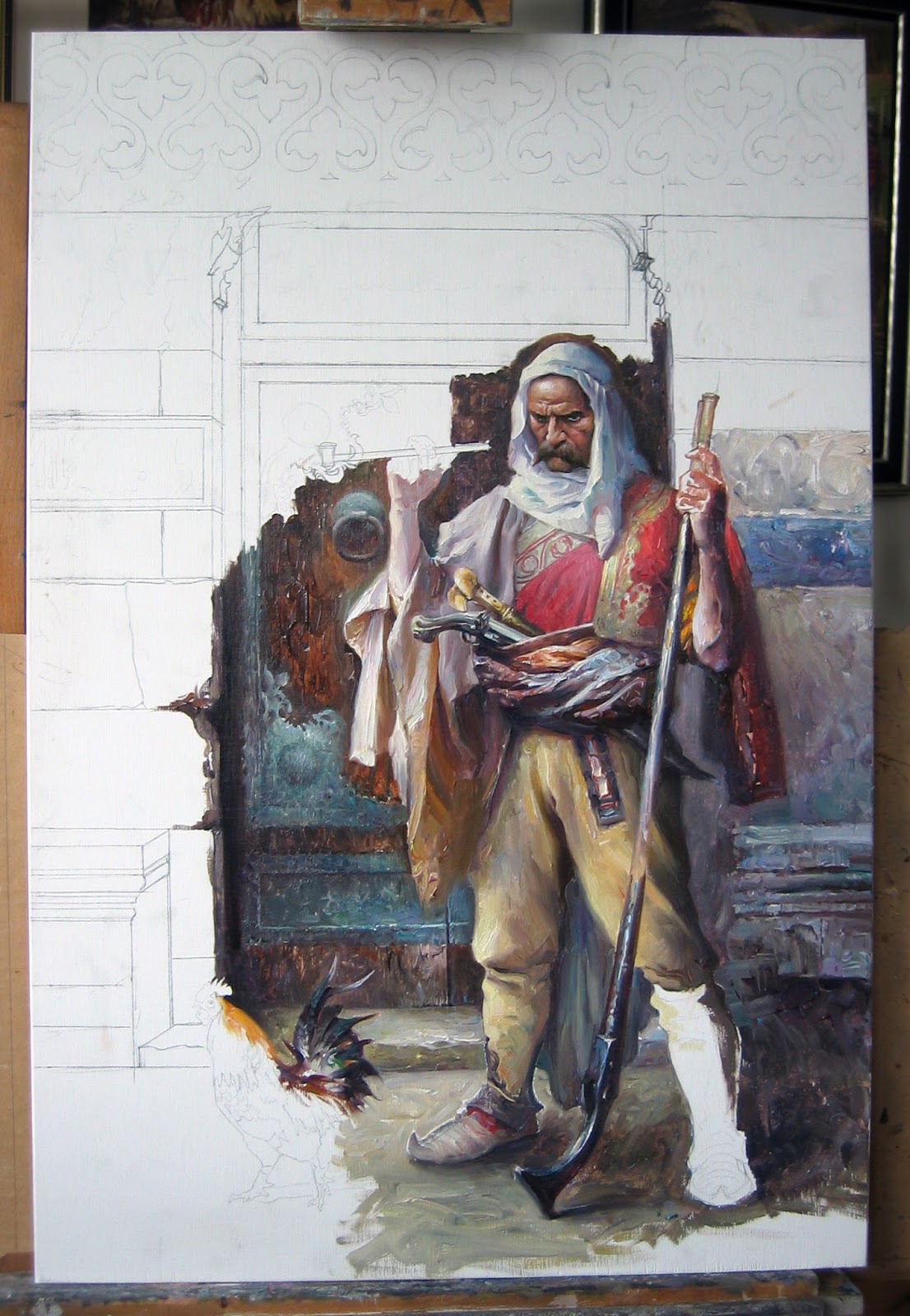 |
| The Sentinel: Homage to Paja Jovanović |
Recently, I posted an image on Facebook of a painting in progress (The Sentinel: Homage to Paja Jovanović). Most of my Facebook friends, as it is called today, liked the presented image – some were intrigued, others puzzled by my way of working. A puzzled person asked why I paint like that? Another one was impressed by the “magic” of the process and suggested that I should go on television and present my skills to the kids to enjoy and be amazed by. There was a person who, quite genuinely and with best possible of intentions, advised me not to post such images online anymore because the “real” painters might think I am an amateur. A proper way of working on a painting, as he correctly pointed out, demands that the artist works simultaneously on different parts of the picture, gradually working his way toward the completion of the entire piece.
To make things clear, I did not feel insulted by any of these questions and comments, nor did I think they were silly, or mean. They were genuine and by the book…well, by a book. I perfectly understand that we, people, often have troubles understanding the dynamics and the logic of a level, or a stage, we are not familiar with, or the insights we are not yet up to.
What they did not know was that I spent decades working by the book, so to speak, following, as best as I could, clever and inspiring instructions and insights of those who preceded me on a similar kind of endeavor, and with which they paved and enlightened the path for me. Throughout my entire career, I spent countless hours preparing reference material, doing sketches and preliminaries, and making elaborate and complex underpaintings, some of which were in fact finished monochromatic pictures. But… but, about a year ago, I realized I did not need any of this anymore. And although I still spend much time on preparations, especially on creating a very detailed digital reference, I do not need the underpainting anymore. I might do a little bit of underpainting here and there when a specific under-color is needed, but generally I stopped working in this way – the thing that was previously very helpful, has become now restrictive and annoying. At the same time, the irresistible call of the virgin white painting surface and the freshness and vitality of the first, juicy brushstrokes became so attractive to me and delicious to work with, that some other aspects of my previous painting process did not matter anymore and were abandoned, or pushed to the background. The fear of paint, my faithful friend and companion, seems finally to have left me.
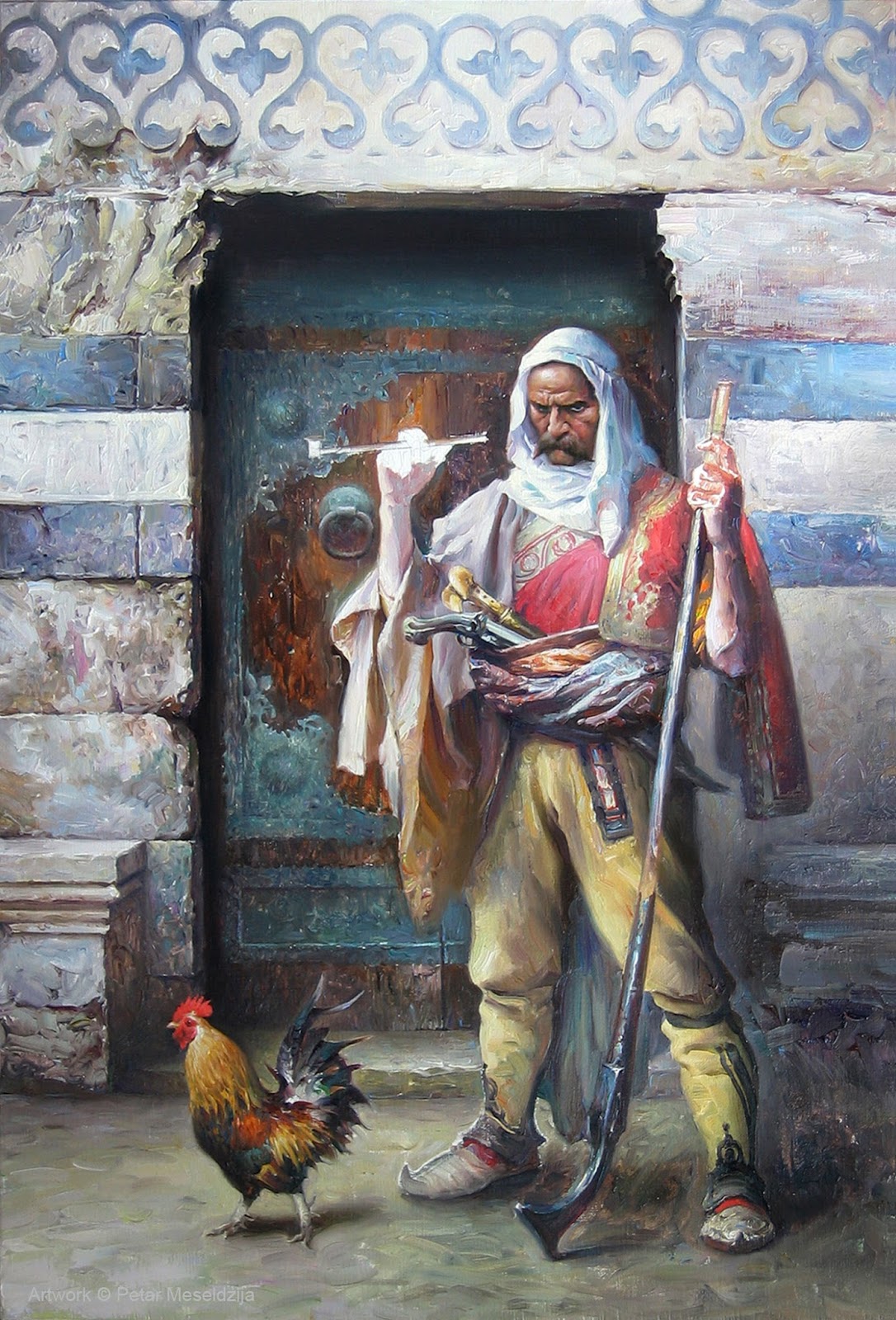 |
| The Sentinel: Homage to Paja Jovanović, still in progress. |
I realized that I have finally arrived – I finally “graduated” from my own school, my own art academy – I finally learned to paint (it’s funny to feel that way after more than 25 years of painting). Moreover, I understood what my hand – being a metaphor for the painter’s creative spirit – wants me to do, and how to do it. So, thus I entered a new level, a new stage of artistic development with new set of rules and challenges.
Nevertheless, I am not the first, nor the last one to have made this particular journey, this transition. Perhaps you are next…So, good luck!


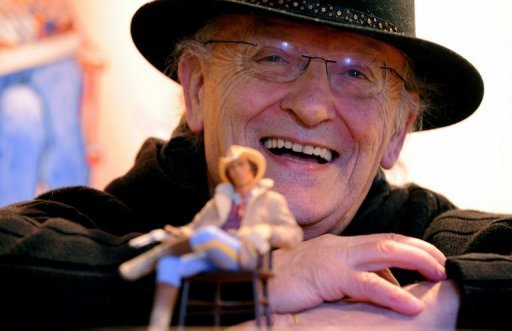

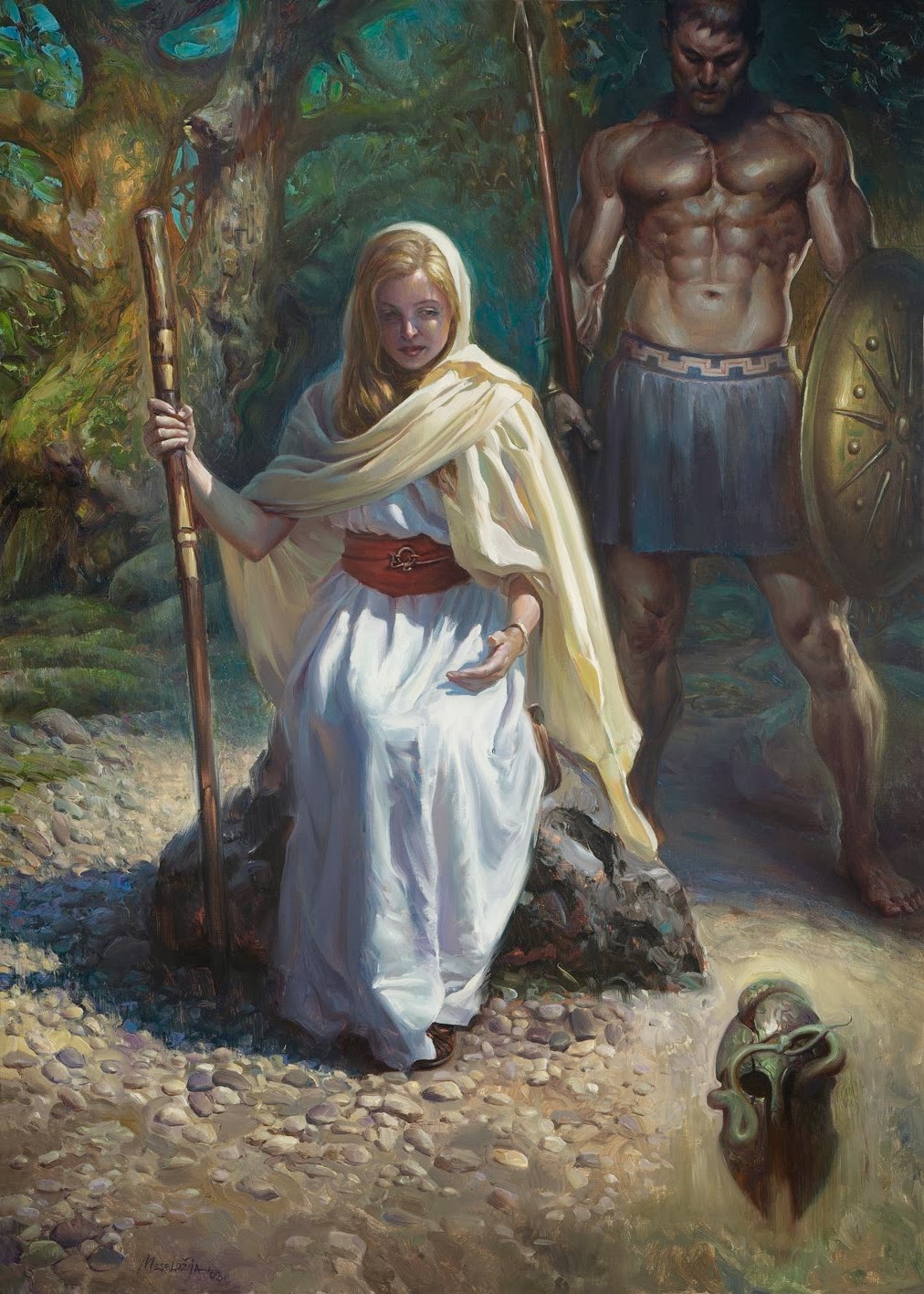
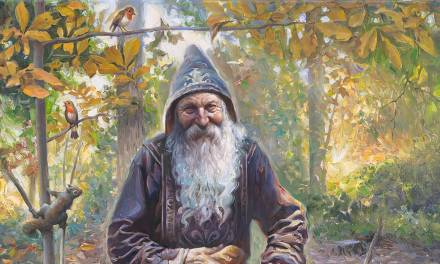
“The fear of paint, my faithful friend and companion, seems finally to have left me.”- I think that says it all (along with the painting-it's fantastic). Thanks for a GREAT post Petar. Bravo!
I have been painting like that on canvas for a while, to me it just feels more comfortable. I have a solution in my head and when I try to paint with under paintings or other methods it fails. It gets muddy and I feel a loss of control in the painting, When I simply put my paint directly on the canvas I feel that it works out much better.
I really like this shift in your artistic development Petar. This is essentially how someone paints when they first try it, and have no concern about traditional rules and methods. It is refreshing to see this change in your approach. You have come full circle! Actually, a lot of artists paint that way, directly with no layers.
While the full underpainting can be very helpful, there are a lot of downsides. The painting takes longer because it is painted twice, and that can lead to lack of enthusiasm and spontaneity. The parts of the underpainting that shows through gives a unifying color to the artwork, yet that is also a problem as it can overly influence and deaden the colors with the (usually) brownish tones. And the underpainting blocks the white gessoed surface, losing potential luminosity when applying paint transparently. So yeah, why not just skip all that stuff and just paint?
I also note a change in subject matter, which I applaud. While I love the fantasy genre, it is great to see you break out of that mold.
This painting blew me away. Fantastic!
(On a sidenote, I'd actually like to hear more about your digital references… maybe I need to search through the blog history)
As far as working the whole painting simultaneously being the “right” way of painting, James Gurney has a great blog post about this: http://gurneyjourney.blogspot.com/2008/06/area-by-area-painting.html
And I have a quote from a 19th century book by Solomon J Solomon:
“Many roads lead to Rome, so on another occasion try a different method… Make your drawing, and on the bare white canvas complete absolutely each object separately, bearing in mind, while painting it, its relative value to the whole. This is excellent practice, and will best enable you to finish. Experience gained in this way is invaluable: you will see when the study is done whether you have over- or under-stated the value of the tone of any particular part. I should advise you to begin with the object strongest in light and shade, so as to set the key for the whole, and paint it up to full strength, or you will find most likely, when the surroundings and background are painted, that it may look weak.
It is quite possible to complete a picture bit by bit in this way. Many of the students in the Ecole des Beaux Arts in my time began their studies from the nude at the head and worked down to the feet without retouching; and such studies, when completed, were often perfect in the relative value of the parts to the whole.”
–Solomon J Solomon, describing this same technique used at the Ecole Des Beaux Arts in the 19th century!
Thank you!
Many people paint like that, from children, to amateur artists, to professionals. At the end, the final results have to justify such an approach, or not….Thanks, Richard!
Indeed, we are often told about the positive aspect of working with underpainting and such, but seldom about the possible drawbacks and limitations of such an approach. Therefore, it is, I believe, necessary for each artist to find out what is more important to him – to work with, or without underpainting. These are delicate questions that require an answer based on experience and self-knowledge… As for change in subject matter, that, too, has to evolve and change as our growth continues and our perception changes, given that we are sufficiently one with ourselves, and not too fragmented. Although Fantasy Art will always stay close to my heart, it has become too restrictive to my further development. This is not a question of conscious decision, but rather an intuitive step toward a broader and fuller expression of the creative spirit that drives me… Thank you, Joel!
Well, that's very interesting!Of course I knew the work of Solomon J. Solomon, but I did not know we shared the same opinion on this particular topic – my thoughts precisely! You see, that's another example, or a proof, that the “Many roads lead to Rome” proverb might be true after all 🙂 Thank you, Keith!
Nice post and super gorgeous painting! The colors of that door are amazing!
The best part of this post (to me) is how different you now perceive the criticism/opinions of others. I once criticized a painting of yours here on MuddyColors, because Conan was looking at the viewer instead of his adversary. Boy, did I regret that! Your response had me reeling for days 😉
My view on what & how art should be was based heavily on convention, what others said how it should be … and hence I was wrong. My sincere apologies for that!
This is a terrific post that's very topical to me at the moment. I've never been much of a painter (understatement), but lately I've found myself wanting to paint more and more. It's been over ten years since I had any training in it but something about the medium has been kind of whispering to me. So I've been trying to visualize the process and how I would approach painting now that I'm more established as a digital artist. Reading this reinforces my thoughts that I should just “go for it.” I'm usually very concerned with carefully managed detail, but painting seems like an opportunity to really let creativity live outside of the safety of an under-drawing. It's always seemed to me to be the medium most capable pure expression.
As for the piece you're working on: you're nailing that orientalist feeling. Your influences are loud and clear. I'm really enjoying it.
No need to apologize, Nicolay! As you can see from this post, I am still developing and changing myself, and not only artistically. I have made many mistakes in the past, and will continue to make them in the future, no doubt about that. The way I perceive the criticism now is not fundamentally different from how it was before, only my reaction to it is somewhat different. In other words, I learned to see it in a different perspective and that enabled me to suppress my flamboyancy more effectively and thus react more properly. It's a delicate business to “separate wheat from chaff”, to discern a constructive criticism from the mere personal projections of the critics. You just cannot take everybody's opinion in consideration, for you need to understand and deal with the level / angle the criticism comes from, as well as to respect your own character and sensibility. There is something in us that transcends our ratio and common sense, and as an artist, I believe, you have to try to tune to it.
Sure you have to go for it, Bo! Do and create things with your own bare hands, express yourself more freely and purely, be in direct contact with matter(feel it), which is the very foundation of our life and the world we live in…what else could be more important!
A bit late, but I just wanted to say that I agree completely with your views here, Petar. I have not travelled as far as you in my artistic development and so I still find myself trying different methods or roads to complete a painting, but those are methods that are less and less influenced by the opinion of others and more based on what I am interested in and what works for me. I find that going against the current requires a large amount of courage, and I would even call it faith to some extent. And you definitely seem to have that courage, and the confidence to not be upset when people question your way of working but instead understand their perspective. If nothing else I believe this wonderful painting is a testament to it! Thank you!
Yes, Staffan, going against the current does require much courage – that's why it is often called “The Road Less Traveled” – but things like stubbornness, persistence, a certain amount of arrogance, idealism and self-awareness are also crucially important for the success of this lonely endeavor. In other words, you must have a very serious and important motif for offering your relatively comfortable life withing a group for the sake of discovering more about your true and unique self, for this is much more than just an artistic journey…it is essentially a spiritual adventure, and the artist within is just a path, or a mask, that will be discarded after it has fulfilled its function….but, we should not go too far at this moment.
Thank you, Staffan!
Hi Petar. Very nice paiting ! This Charakter is an aIbanian highIander from the north highIands, the head-wear is wrong, the coth is outside the so caIIed “pIis” ( piIeus ) not under, and its weared different. check this out http://www.trepca.net/foto/kulture/ushtari_shqiptar_shek19.jpg
대전출장마사지로 쉽고 간편하게 집에서 경험해볼 수 있습니다.